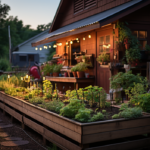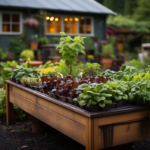Table of Contents
Effective Strategies for Controlling Unwanted Weeds in Your Vegetable Garden
Hey there, green thumbs!
You know the drill – spring arrives, you prep your soil, plant your seeds, and voila! You start seeing specks of green pop up from your vegetable garden. But wait, those aren’t your precious veggies; they are pesky weeds. Grrr…
Look, we’ve all been there. We’ve had to deal with these stubborn invaders who just love to make themselves at home in our lovely vegetable patches. Weed invasion can be frustrating, I get it. They can take away nutrients, space and sunlight meant for your tasty vegetables, and pretty much just annoy the heck out of an otherwise perfect garden.
But here’s the silver lining – arm yourself with a bit of knowledge and some weed-busting strategies, and you can turn the tide in favor of your veggies. So, whether you’re a pro gardener or a newbie, stick around as we delve into the nitty-gritty of dealing with weeds in your vegetable garden. Because we are all about trying to keep those greens growing, and the weeds hoeing! Let’s dive in, shall we?
Understanding the Enemy: Identifying Common Garden Weeds
Don’t sweat it, folks! The first step towards dealing with garden weeds is getting to know what you’re dealing with. So let’s play detective and suss out these veggie garden invaders.
First up on our lineup of usual suspects are the Dandelions. Yeah, the ones with the striking yellow flowers that transform into fuzzy puffballs. Cute, right? Well, don’t let their looks deceive you – these guys are tough cookies that can withstand harsh conditions. Their deep and strong roots make them particularly hard to eradicate.
Next, say hello to Bindweed. This sneaky little fella likes to twist around your vegetable plants, stealing their sunlight and nutrients. You might find its trumpet-shaped flowers charming, but trust me, you don’t want these guys throwing a party in your veggie patch.
And then, we have the Crabgrass. With a name like that, you’d expect it to be awful, right? Well, you’re not wrong. This weed spreads rapidly and has an uncanny ability to regrow even after cutting it. Its prolific seed production means you’ll have a real battle on your hands.
Finally, let’s not forget about the Purslane. This one’s a bit of a firecracker with a knack for surviving even in poor soil conditions. And they propagate like there’s no tomorrow, making them a challenging weed to control.
Recognizing these common garden weeds is crucial. It helps you understand what you’re up against, enabling you to strategize your defence. In our upcoming sections, we’re going to delve into the most effective strategies for dealing with each of these villains. So hold on to your gardening gloves – it’s time to wage war on weeds!
Prevention Tactics: Building a Weed-Resistant Vegetable Garden
Real talk, fellow garden warriors – prevention is the absolute key in having a relatively weed-free vegetable garden. So, let’s chitchat about the art of mastering this unending game of keep-away with those pesky weeds.
To start, let’s get jiggy with mulching. This method is your secret weapon. Aside from keeping your veggies hydrated, a three-inch deep blanket of organic mulch around your plants will prevent weed seeds from seeing the light of day. The result? Fewer uninvited guests in your garden party!
Next on the docket is smart watering. Here’s the deal – your veggies love water, and so do weeds. So let’s plan a strategic water attack. By watering only the root zone of your plants rather than the entire garden, you’ll ensure only your veggies get the hydration they need, leaving our weedy frenemies high and dry.
Furthermore, consider the practice of interplanting. It’s a ninja-like tactic where you mix up plants that have different growth periods together. This way, as one plant matures and is harvested, there’s another already gearing up to take its place, leaving no room or time for weeds to encroach.
And last but not least, let’s think about planting in raised beds or containers. These options give you fantastic control over the soil and conditions your veggies grow in. It’s like creating a fortress against weed invasion.
Remember guys, in the weed-control game, offense is the best defense. Applying these prevention strategies can help ensure your vegetable garden remains a fortress impervious to weed domination. So, gear up, strategize, and happy gardening!
On the Defensive: Effective Tools and Strategies for Weed Removal
Alright, it’s time to roll up our sleeves, my fellow garden warriors! Despite our most valiant efforts, some bold weeds may break through and attempt to take over our beloved veggie patches. But fear not. Let’s talk about the tools and strategies in our weed warfare arsenal.
First off, meet your new best friend, the hoe. This trusty tool is absolute gold when it comes to slicing weeds off at their roots. The trick here is to weed when the soil is dry. Why? Well, in dry conditions, those decapitated weed carcasses aren’t able to reroot into the soil.
Next up, the garden fork. For pesky weeds with deeper roots like dandelions, the garden fork will do wonders. With their long, pronged teeth, they can loosen the soil and uproot the entire weed, root, and all!
And let’s not forget the weed puller. This tool is a life saver for your back and an absolute nightmare for weeds. Its claw-like structure pulls the entire weed, root and all, without you having to bend over – it’s win-win!
However, perhaps the most significant tool in our weed-defensive strategy doesn’t cost a penny: regular maintenance! It sounds simple, but trust me folks, keeping an eye on your garden and dealing with any emerging weeds promptly is a game-changer. Regular weeding can be pretty therapeutic too, so it’s a win all around!
So there you have it. Grab these tools and wear that garden warrior badge proudly. Even though total weed eradication is impossible, effective removal strategies can definitely keep these invaders under control – saving your vegetable garden from their clutches! Happy weeding, folks!
Organic Solutions: Employing Natural Weed Killers and Suppressants
Alrighty, my eco-friendly green thumbs! Are you feeling a bit uneasy about using harsh chemicals to control your weed situation? Well, your garden is in luck. Mother Nature’s got your back with some incredible organic solutions that are just as effective, minus the harm to our beautiful environment.
Our first star player in the organic game is vinegar. Sounds surprising, right? But trust me, this kitchen staple is indeed a weed nightmare. The high acetic acid content burns the weed and changes the pH of the soil causing a local hostile environment. But remember, vinegar doesn’t discriminate between weeds and veggies, so a good ole spray bottle will help target only the intruders.
Next in line is a bit of a surprise celebrity – newspaper! Here’s the deal – by laying a thick layer of damp newspaper around your plants, you create a light-blocking barrier that smothers weed seeds beneath. Top it up with some mulch, and you’ve got yourself a weed suppressant blanket.
Churning out those morning coffee grounds? Don’t toss them out just yet! Coffee grounds are a fantastic natural weed suppressant. The leftover caffeine inhibits the growth of weed seeds, and they enrich your soil with nitrogen too.
And for those stubborn, tough-to-kill weeds, let’s call in the ‘Big Guns’ – corn gluten meal. It’s a natural pre-emergent which means it stops the weeds before they sprout, plus it adds some nice nutrients to your soil.
So, there you have it! With these eco-friendly weed fighters at your disposal, not only can you control the weed invasion, but you can also sleep easy knowing you’re doing it the greenway. Cheers to that, my earth-loving buddies!
Reclaiming Your Garden: Proper Maintenance and Weed Control
Let’s get real for a sec – the art of battling weeds is ongoing, but guess what? With the right maintenance steps and some good habits, you can effectively control these pesky veggie-garden villains and declare your garden a weed-free zone. Yes, you heard me right – it’s reclaiming time!
First off, remember the golden rule: Early detection is key. Don’t let those weeds get too comfy or spread their seeds. When you spot one, consider it a threat and act fast. Weed pulling can become your new zen practice, keeping your garden tidy and your mind relaxed.
Next, let’s think about Rotating Your Crops. Moving your veggies around every planting season can throw weeds off their game. It also helps prevent disease build-up and balances nutrients in your soil. Pretty nifty, huh?
Also, consider Cover crops. Planting cover crops isn’t just for commercial farms. These plants grow quickly, cover your soil keeping it occupied and nourished over winter, and prevent weeds from moving in. Knock out!
And most important, Regular Soil Enrichment. Investing in your soil’s health is like building a strong foundation for your vegetables to thrive and for weeds to fail. Compost, mulch, and compost tea are all fantastic for this.
Make sure to also keep your tools clean. Just as weeds can sneak into your garden via wind and animals, they can also hitch a ride on your gardening tools. A quick clean after gardening can prevent spreading weed seeds.
Alright, garden warriors, now you’re armed with all the weed-busting knowledge needed to reclaim your beloved vegetable garden. Remember, the goal is to control the weeds and not let them control you. So, go forth and enjoy your weed-less garden journey – you’ve got this!
Learning from Nature: Companion Planting to Discourage Weeds
Okay folks, here is where things get pretty exciting. Who says weed control strategies can’t be buddies with boosting your harvest? It’s time to delve into the clever world of companion planting, a tactic that learns from nature itself to bring harmony to your garden.
First up, let’s talk about the heavyweight champion of companion plants, Marigolds. Besides adding a splash of golden sunshine to your vegetable plot, these beauties are super at deterring weed growth with their allelopathic properties. And as a bonus, many pests don’t particularly fancy them either!
Next on the list are Herbs. Yes, they’re great for adding that extra zing to your culinary delights, but they’re also amazing at being natural weed suppressants. Plants like rosemary and thyme grow thickly and can form a good protective layer over soil, preventing weeds from gaining a foothold.
Move over for the VIP – Cover crops like clover and vetch, which provide green manure. Their rapid growth and dense coverage leave little room for weeds to settle. Plus, when it’s time to plant, just cut them down and let them compost directly on the soil, giving it a nutrient boost!
Have a look at companion vegetables – like bush beans and corn. When planted together, they make the most of garden space, leaving little room for weeds to take over. The bush beans creep along the ground, acting as a living mulch, while the corn shoots up high, making life difficult for any aspiring weeds.
So, who knew that the natural world could teach us such invaluable tactics in our ongoing garden battles? With companion planting, you can turn the tide of the war on weeds, encouraging a thriving, bountiful vegetable garden. So grab your seeds and let’s get (companion) planting!
When Weeds Fight Back: Dealing with Persistent and Invasive Species
Alright, let’s face it – in the big wide world of weed battling, sometimes you come across those stubborn, persistent guys that seem almost super-powered. They are the tenacious ones that keep coming back, no matter what tactics you’ve tried. But hey, we’re garden warriors, and we’re not giving up. Let’s get into the thick of handling these weed-nemeses.
First, there’s the notorious Bermuda grass – tough to the core and spreads like wildfire. To declare victory over this beast, physical removal alone won’t do it. A combined strategy of smothering with heavy mulch, regular mowing to weaken it, and diligent root-removal can eventually conquer this green monster.
Then we’ve got Field bindweed, putting our patience to a true test with its vigorous spread and deep, persistent roots. Pulling or hoeing won’t be sufficient. Here, a suppressive mulch layer, a sturdy weed barrier, and planting high-density cover crops can stifle its growth over time.
Hold onto your hats, for here comes Kudzu, also known as the “plant that ate the south” for its invasiveness. The battle strategy here needs to be relentless mowing and grazing till you exhaust the plant’s energy reserves stored in its roots.
Consider Japanese knotweed, famously known as “Godzilla weed” due to its invincibility. Professional intervention might be needed to control this one, yet repeated cutting and applying organic weed killers can curb its growth.
Battling these super-weeds demands patience and persistence equal to their own. But armed with knowledge, the right strategies and the will to protect our precious vegetable gardens, we can keep even these tough customers in check. Stay strong, garden warriors – persistent and invasive species, be warned, we’re not backing down!
FAQs: Quick Answers to Common Weed-Related Queries
Hey there, garden gurus! We know that the battle against weeds can leave you with a head full of questions. Well, we heard you loud and clear! So, let’s tuck into some of the most frequently asked weed-related questions you’ve been itching to know about.
1. Why do weeds grow so fast?
Here’s the thing – weeds are survivors. They have a rapid reproduction cycle and can adapt to a vast array of conditions. That’s why they seem to grow almost like they’re on steroids!
2. Is pulling weeds a waste of time?
Absolutely not! Pulling weeds before they seed controls their spread. So, channel your inner weed warrior and pull away – it’s totally worth the time.
3. Can I compost weeds?
Yes and no. Composting weeds is okay, but only those that haven’t yet flowered or gone to seed. Otherwise, you might be inviting a weed fest to your compost, and nobody wants that, do we?
4. Do weeds have any benefits?
Hold up – benefits, really? Indeed, some weeds can be of use. Certain types like clover and vetch can improve soil health. Some are even edible! But let’s not give weeds too much credit here – your veggies are the real stars of the garden.
5. Do I need to use commercial weed killers?
Well, that’s your call. Commercial weed killers can be effective, but they’re not the only option. Many organic methods and preventive measures can be just as successful – and nicer to the environment, too!
Remember, grabbing those weeds by the root might be a challenge, but with the right know-how, it’s a battle you can definitely win. So spread the weed wisdom and keep those excellent questions coming – together, we can keep our vegetable gardens flourishing!
Conclusion
And there you have it, fellow garden enthusiasts – everything you need to tackle those pesky weed invaders in your vegetable garden! From identifying those unwanted guests, to organic and natural solutions, up till your frequent queries – we’ve got you covered.
Be patient and persistent, folks; remember, gardening is a journey, not a destination. And as you toil away, just think about the wonderful taste of those fresh veggies you’ve nurtured right in your backyard.
Battles will be fought, and you may even develop a grudging respect for those persistent weeds. After all, nature never stops. But at the end of the day, your flourishing vegetable garden will stand as a testament to your efforts.
So whether you’re a seasoned gardener, or just rolling up your sleeves for the first time, never fear those weeds again. Instead, draw on these strategies to welcome a greener, healthier, and weed-controlled gardening experience. Keep gardening, keep growing and remember – every lovely veggie is a victory against the weeds!
Catch you in the next post, until then, keep those green thumbs flexing and the weeds hoeing! Happy gardening, everyone!









